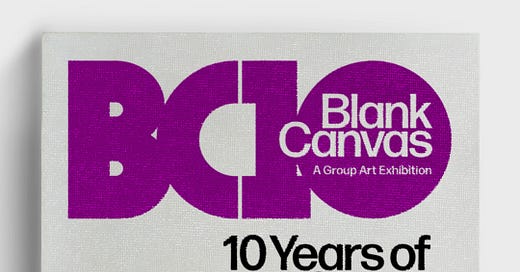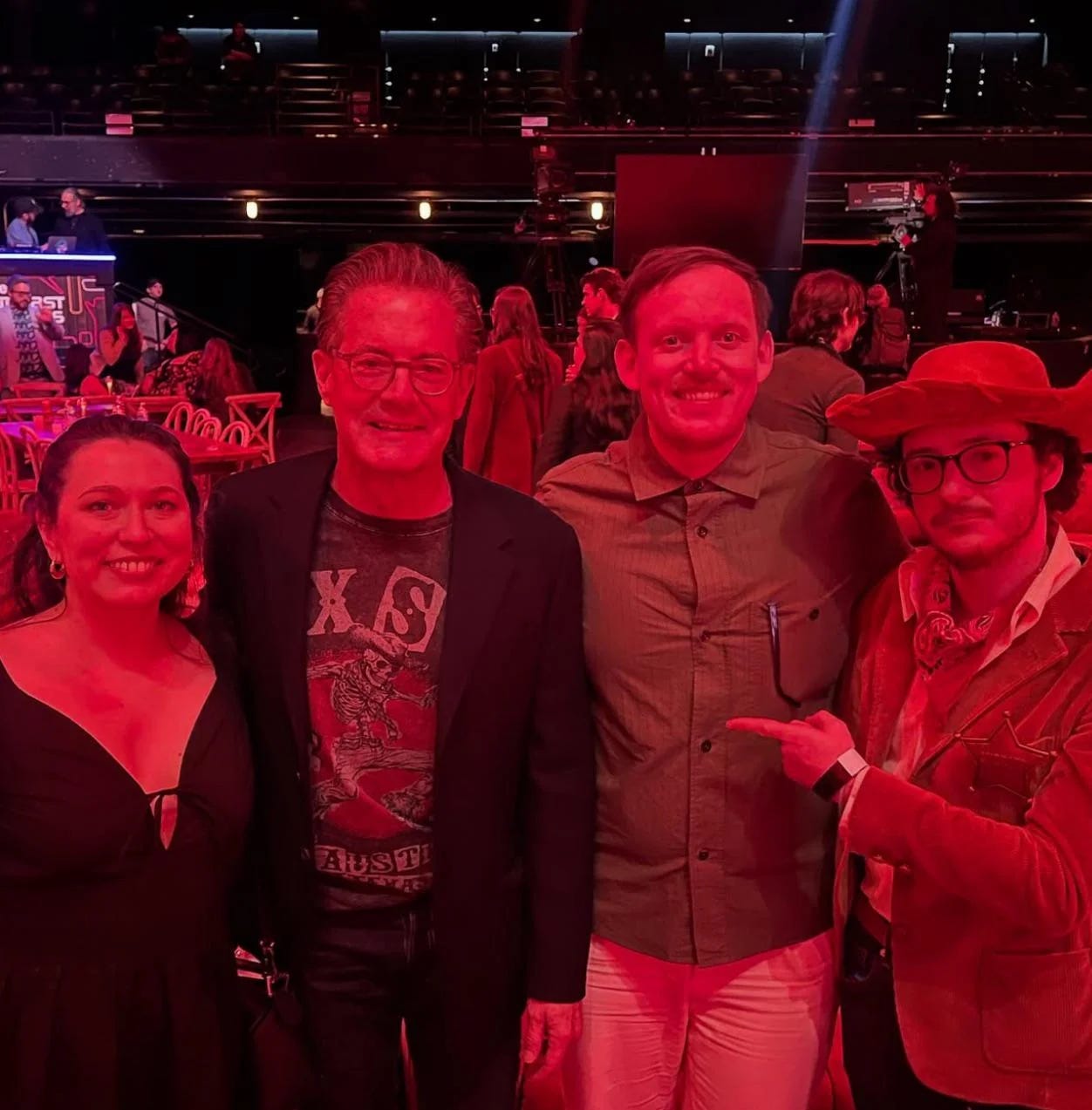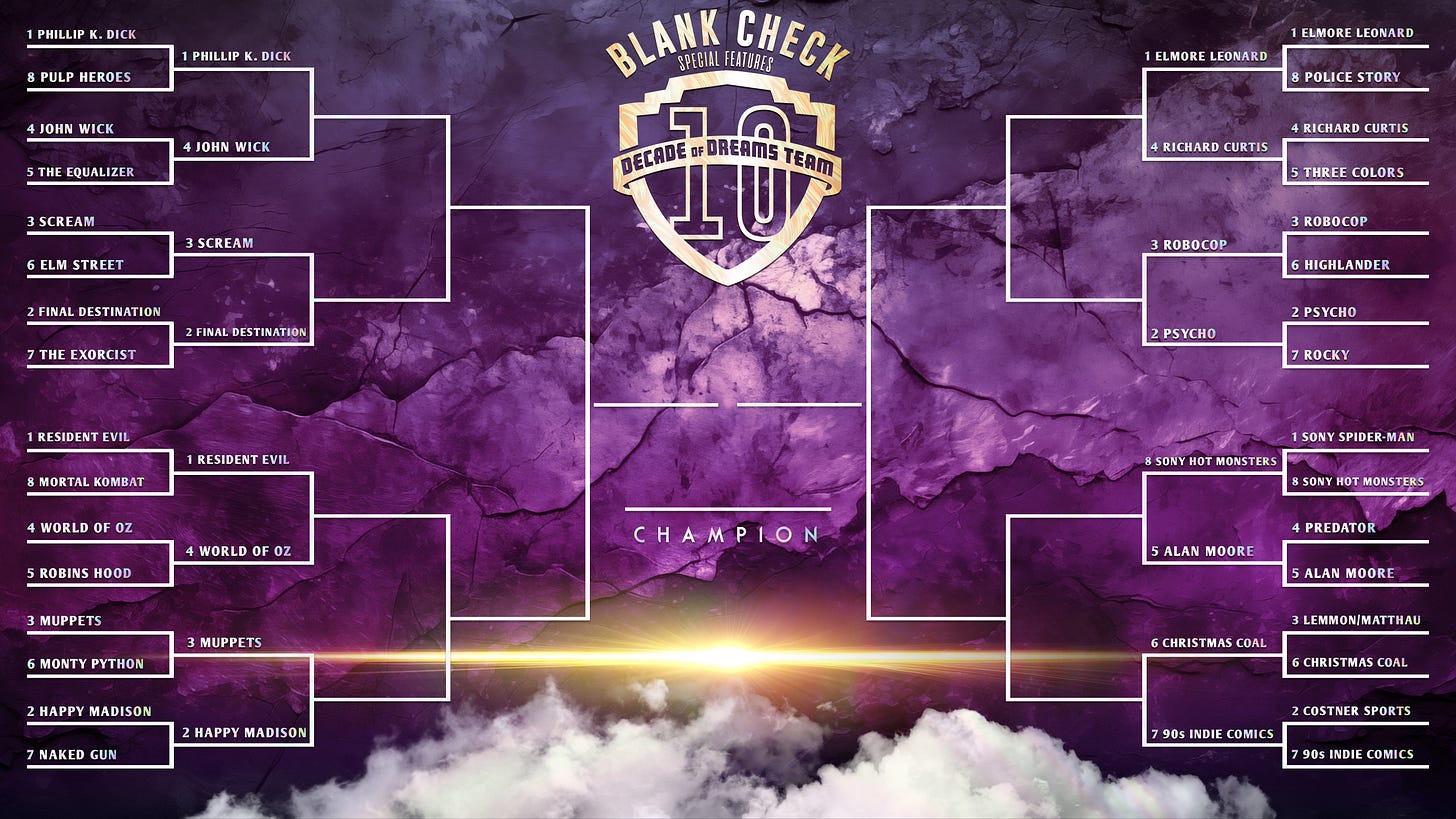Surprise! Blank Check has started a newsletter! Your favorite connoisseurs of context are gonna go on even more tangents, commit to even more bits, and share opinions on even more pieces of entertainment industry news because - hey, why not. Thanks for joining us!
IN THIS WEEK’S EDITION:
THE BARDI PARTY REPORT
EXTRA EXTRA, READ ALL ABOUT IT!
This week we are doing something unprecedented for a podcast about movies. We are hosting a legitimate, highbrow, creatively-inspiring downtown New York art show!
Join us from March 21st to March 23rd at CODA Gallery, located at 210 Rivington Street, New York, NY 10002.
The show is open to the public Friday and Saturday from 11 AM to 6 PM and Sunday from 11 AM to 5 PM
This special event will showcase exclusive prints from MURUGIAH, Ryan Gajda, Bryan Lee O'Malley, Kevin M. Wilson, and Joe Bowen, as well as unique works from Brad Hill, Sara Rubin, Abigail Noy, and Truck Torrence. And that’s just to name a few…
First-run prints will be available exclusively in person at the show (limited stock). Any remaining inventory will be available later via our partners at Mutant at MadeByMutant.com—stay tuned for details!
Plus, take a trip down memory lane with a curated selection of Blank Check ephemera from over the years—including the envelope??? Buried jeans??? Maybe a full-ass porch???
This is going to be the ultimate showcase of Ben’s creative energy, Griffin’s ambition/love of movie merch, and David’s “I dunno, what do you want from me???!?!” sprinkled in for effect.
It’ll be fun! I’ve heard rumors of some groundbreaking performance art taking place…………….
Some odds and ends from me after a week of JET SETTING & EXHAUSTION:
Happy St. Patrick’s Day! In an impeccably timed announcement, the Academy has revealed that Irish-American icon Conan O’Brien will be returning to host the Oscars next year! Huzzah!
In less enthusiastic news, this weekend at the box office was dismal in terms of receipts - the lowest grossing weekend of the year thus far, with the Jack Quaid-fronted action flick Novocaine taking the top spot by default. Soderbergh’s Black Bag cost $50M to produce and earned a whopping $7.5M in its first weekend, tying with Mickey 17 for second place. I haven’t seen any of these movies yet because I’ve been BUSY, but I would love to see the Sodey, the Bong, and maybe the Looney Tunes if you people tell me if it’s any good.
I did watch The Apprentice on my flight yesterday. Jeremy Strong was ROBBED of the Best Supporting Actor Oscar this year.
We lost at the Podcast Awards to How Did This Get Made, and to add insult to injury, they didn’t even announce the Film/TV category during the show. We did get to meet Kyle MacLachlan, though. He didn’t know who we were but we got a photo anyway.
LET’S CRACK OPEN THE DOSSIER
When Empire of the Sun producers Frank Marshall and Kathleen Kennedy were initially told that it would likely take around four years to obtain permission to shoot in China, the married producing duo scouted a wide variety of potential alternate shooting locations, including Buenos Aires, Stockholm, Vienna, Hong Kong, Lisbon, and Liverpool. However, none of those other locations proved necessary, as negotiations between the production and Shanghai Film Studios and the China Film Co-Production Corporation ended up taking just a single year, granting Steven Spielberg 21 days of then-unprecedented access to China for an American film director.12 In order to get the most out of their three weeks in the country, Spielberg and his crew made extensive pre-production preparations, as laid out here by cinematographer Alan Daviau: “The thing of getting people and equipment in and out of China is something that takes months of advance planning. You understood in November you weren’t going to shoot until March, but the decision on what equipment would go to China had to be made right then, because equipment going by sea took over two months’ travel to get around the world.”3
One of the biggest decisions the production had to make was how to handle each day’s footage: while China was home to a number of state-of-the-art facilities, Daviau had “talked to others who shot there,” and he found that “generally the answer was that technically the labs in Asia are wonderful, but with the vagaries of language… you might not be able to communicate the subtleties of certain things and have them come back correctly the first time.” So Spielberg and Daviau instead decided to ship the film back to the production’s headquarters in England, per the cinematographer: “[W]e judged airline schedules and figured that it could be done sending everything back to Technicolor London just as efficiently as anywhere else. Every night, if we cut off at a certain point in the afternoon, we could make an evening flight from Shanghai to Hong Kong and get it on the Cathay Pacific flight in Hong Kong which would get the film through to London the next morning.” But shipping the film back to Shanghai after it had been processed would likely have proved more trouble than it was worth, so Spielberg and Daviau were forced to complete their China shoot—which included extremely complex outdoor sequences brimming with 5000-plus extras—without seeing any dailies: “Upon checking with customs brokers and agents it was determined that it would be asking for a lot of difficulties to try and return dailies to Shanghai so that we could see them. So we made the decision that makes every cinematographer shudder, which is to fly it blind — so I would not see any dailies for the three-plus weeks in Shanghai.”4 At the end of each shooting day, Daviau and Spielberg would take a 6 P.M. call with Technicolor London in which technical advisor Bob Crowdy and Spielberg’s longtime editor Michael Kahn would express their own feelings about the footage, which Spielberg and Daviau would then have to rely on to shape the subsequent days of production.
After the completion of the Shanghai shoot, the production decamped for England first—where shooting was primarily done on location, but also, for a few days, on stages at Elstree Studios, the home of the Indiana Jones franchise—and then Spain—where the film’s prison camp was built on a vacant lot in Jerez, and where some blue screen footage was shot at a warehouse in Trebujena. According to Daviau, there was just “a total interruption of five days” between the Shanghai shoot and the England shoot. Back in Europe, Daviau was relieved to have quick access to his own footage again: “The joy of shooting in England was that I could go to the lab every morning and see my previous day’s footage before going out to the location. When we went on to Spain we set up a screening room and Samuelsons sent us a wonderful projectionist and two portable projectors.”5 Yet, despite all of the challenges facing the global production, Daviau says that Empire of the Sun was “superbly prepared” and “one of the smoothest productions I have ever been on in my life.”6
Though the production was efficient—as Spielberg told The New York Times, he was, by that point, “accustomed to working through problems in logistics”—it was still an arduous experience for the director emotionally. He described Empire of the Sun as “not a happy experience,” claiming that he was “very disturbed” making it. Much of this was due to Spielberg’s pained attempts to pivot away from his directorial instincts: “I was doing things against not the grain of my intuition, but against the collection of my own experiences as a director. I was making a movie that when I would discover how to slightly subvert the drama through humor, I would have to count to 10 or hold my breath - and not do it. I’m always trying to infuse humor into any situation. The more dramatic the situation, the more fun I have trying to find the lighter side to the darkness. And in this case, I had to really bite my lip to drown out where my kick reflex from all my other films was taking me. It was a real internal struggle to get this thing on the screen and not mess it up.” Ultimately, Spielberg didn’t think that he’d “made a dark movie.” But Empire of the Sun was, in his view, as “dark as [he’d allowed [himself] to get,” which he found “perversely very compelling.”7
MARCH MADNESS UPDATES!
We’ve entered the SWEET SIXTEEN!
Here’s where we stand after the first round of March Madness! What are your biggest surprises of the tournament thus far? Mine would be FFC defeating Edgar Wright and Gore Verbinski putting up a weak performance this year after he almost derailed my first MM tournament in 2021.
Today, you can vote for either PTA (1) or Ridley Scott Pt I (5) in our main-feed challenge, and for either Philip K. Dick or John Wick on our Patreon.
I can’t stop giggling over “Dick v. Wick.”
THIS WEEK ON THE PODCAST
Bilge Ebiri joins us and joins the five timers club as we talk about 1987’s epic Empire of the Sun. There’s also a lot of Horizon Chapter 2 chatter as well:
And on Patreon, we’re in Speilberg side-project land with Twilight Zone: The Movie (cursed, obviously) / Amazing Stories.
COMING SOON:
Joseph McBride, Steven Spielberg: A Biography, 486/Ian Freer, The Complete Spielberg.
I should also be clear that Empire of the Sun was still an American production—and not a true co-production—as all of film’s funding came from American sources.
American Cinematographer, July 1988.
American Cinematographer, July 1988.
American Cinematographer, July 1988.
Joseph McBride, Steven Spielberg: A Biography, 486.
New York Times, January 10, 1988.




















Surprised to see Soderbergh lose in the first round - expected it would be closer between them given last tournament. Bummed to see Haynes lose but expected it given how long it’s been since Mel’s been up, and Haynes is new enough I think odds are still good he gets covered outside MM.
Patreon-wise, Pulp Heroes losing in the first round a shocker given it was the runner-up last year. Surprised Scream had the edge over Freddy.
Prediction: 90s indie comics, the clear juggernaut over all these repeats. Give us the Tank Girl episode we’ve been promised since Stargate.
The Day The Earth Blew Up is pretty good! Well worth a trip to the theatres.